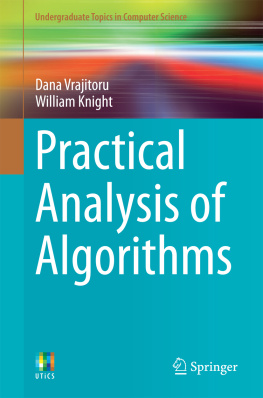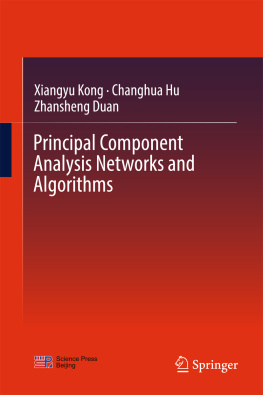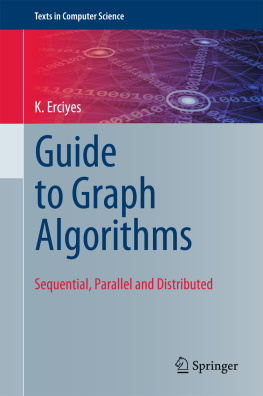Robert Sedgewick - An Introduction to the Analysis of Algorithms
Here you can read online Robert Sedgewick - An Introduction to the Analysis of Algorithms full text of the book (entire story) in english for free. Download pdf and epub, get meaning, cover and reviews about this ebook. year: 2013, genre: Computer / Science. Description of the work, (preface) as well as reviews are available. Best literature library LitArk.com created for fans of good reading and offers a wide selection of genres:
Romance novel
Science fiction
Adventure
Detective
Science
History
Home and family
Prose
Art
Politics
Computer
Non-fiction
Religion
Business
Children
Humor
Choose a favorite category and find really read worthwhile books. Enjoy immersion in the world of imagination, feel the emotions of the characters or learn something new for yourself, make an fascinating discovery.

- Book:An Introduction to the Analysis of Algorithms
- Author:
- Genre:
- Year:2013
- Rating:4 / 5
- Favourites:Add to favourites
- Your mark:
- 80
- 1
- 2
- 3
- 4
- 5
An Introduction to the Analysis of Algorithms: summary, description and annotation
We offer to read an annotation, description, summary or preface (depends on what the author of the book "An Introduction to the Analysis of Algorithms" wrote himself). If you haven't found the necessary information about the book — write in the comments, we will try to find it.
An Introduction to the Analysis of Algorithms — read online for free the complete book (whole text) full work
Below is the text of the book, divided by pages. System saving the place of the last page read, allows you to conveniently read the book "An Introduction to the Analysis of Algorithms" online for free, without having to search again every time where you left off. Put a bookmark, and you can go to the page where you finished reading at any time.
Font size:
Interval:
Bookmark:
Second Edition
Robert Sedgewick
Princeton University
Philippe Flajolet
INRIA Rocquencourt

Upper Saddle River, NJ Boston Indianapolis San Francisco
New York Toronto Montreal London Munich Paris Madrid
Capetown Sydney Tokyo Singapore Mexico City
Many of the designations used by manufacturers and sellers to distinguish their products are claimed as trademarks. Where those designations appear in this book, and the publisher was aware of a trademark claim, the designations have been printed with initial capital letters or in all capitals.
The authors and publisher have taken care in the preparation of this book, but make no expressed or implied warranty of any kind and assume no responsibility for errors or omissions. No liability is assumed for incidental or consequential damages in connection with or arising out of the use of the information or programs contained herein.
The publisher offers excellent discounts on this book when ordered in quantity for bulk purchases or special sales, which may include electronic versions and/or custom covers and content particular to your business, training goals, marketing focus, and branding interests. For more information, please contact:
U.S. Corporate and Government Sales
(800) 382-3419
For sales outside the United States, please contact:
International Sales
Visit us on the Web: informit.com/aw
Library of Congress Control Number: 2012955493
Copyright 2013 Pearson Education, Inc.
All rights reserved. Printed in the United States of America. This publication is protected by copyright, and permission must be obtained from the publisher prior to any prohibited reproduction, storage in a retrieval system, or transmission in any form or by any means, electronic, mechanical, photocopying, recording, or likewise. To obtain permission to use material from this work, please submit a written request to Pearson Education, Inc., Permissions Department, One Lake Street, Upper Saddle River, New Jersey 07458, or you may fax your request to (201) 236-3290.
ISBN-13: 978-0-321-90575-8
ISBN-10: 0-321-90575-X
Text printed in the United States on recycled paper at Courier in Westford, Massachusetts.
First printing, January 2013
PEOPLE who analyze algorithms have double happiness. First of all they experience the sheer beauty of elegant mathematical patterns that surround elegant computational procedures. Then they receive a practical payoff when their theories make it possible to get other jobs done more quickly and more economically.
Mathematical models have been a crucial inspiration for all scientific activity, even though they are only approximate idealizations of real-world phenomena. Inside a computer, such models are more relevant than ever before, because computer programs create artificial worlds in which mathematical models often apply precisely. I think thats why I got hooked on analysis of algorithms when I was a graduate student, and why the subject has been my main lifes work ever since.
Until recently, however, analysis of algorithms has largely remained the preserve of graduate students and post-graduate researchers. Its concepts are not really esoteric or difficult, but they are relatively new, so it has taken awhile to sort out the best ways of learning them and using them.
Now, after more than 40 years of development, algorithmic analysis has matured to the point where it is ready to take its place in the standard computer science curriculum. The appearance of this long-awaited textbook by Sedgewick and Flajolet is therefore most welcome. Its authors are not only worldwide leaders of the field, they also are masters of exposition. I am sure that every serious computer scientist will find this book rewarding in many ways.
D. E. Knuth
THIS book is intended to be a thorough overview of the primary techniques used in the mathematical analysis of algorithms. The material covered draws from classical mathematical topics, including discrete mathematics, elementary real analysis, and combinatorics, as well as from classical computer science topics, including algorithms and data structures. The focus is on average-case or probabilistic analysis, though the basic mathematical tools required for worst-case or complexity analysis are covered as well.
We assume that the reader has some familiarity with basic concepts in both computer science and real analysis. In a nutshell, the reader should be able to both write programs and prove theorems. Otherwise, the book is intended to be self-contained.
The book is meant to be used as a textbook in an upper-level course on analysis of algorithms. It can also be used in a course in discrete mathematics for computer scientists, since it covers basic techniques in discrete mathematics as well as combinatorics and basic properties of important discrete structures within a familiar context for computer science students. It is traditional to have somewhat broader coverage in such courses, but many instructors may find the approach here to be a useful way to engage students in a substantial portion of the material. The book also can be used to introduce students in mathematics and applied mathematics to principles from computer science related to algorithms and data structures.
Despite the large amount of literature on the mathematical analysis of algorithms, basic information on methods and models in widespread use has not been directly accessible to students and researchers in the field. This book aims to address this situation, bringing together a body of material intended to provide readers with both an appreciation for the challenges of the field and the background needed to learn the advanced tools being developed to meet these challenges. Supplemented by papers from the literature, the book can serve as the basis for an introductory graduate course on the analysis of algorithms, or as a reference or basis for self-study by researchers in mathematics or computer science who want access to the literature in this field.
Mathematical maturity equivalent to one or two years study at the college level is assumed. Basic courses in combinatorics and discrete mathematics may provide useful background (and may overlap with some material in the book), as would courses in real analysis, numerical methods, or elementary number theory. We draw on all of these areas, but summarize the necessary material here, with reference to standard texts for people who want more information.
Programming experience equivalent to one or two semesters study at the college level, including elementary data structures, is assumed. We do not dwell on programming and implementation issues, but algorithms and data structures are the central object of our studies. Again, our treatment is complete in the sense that we summarize basic information, with reference to standard texts and primary sources.
Related texts include The Art of Computer Programming by Knuth; Algorithms, Fourth Edition, by Sedgewick and Wayne; Introduction to Algorithms by Cormen, Leiserson, Rivest, and Stein; and our own Analytic Combinatorics. This book could be considered supplementary to each of these.
In spirit, this book is closest to the pioneering books by Knuth. Our focus is on mathematical techniques of analysis, though, whereas Knuths books are broad and encyclopedic in scope, with properties of algorithms playing a primary role and methods of analysis a secondary role. This book can serve as basic preparation for the advanced results covered and referred to in Knuths books. We also cover approaches and results in the analysis of algorithms that have been developed since publication of Knuths books.
Font size:
Interval:
Bookmark:
Similar books «An Introduction to the Analysis of Algorithms»
Look at similar books to An Introduction to the Analysis of Algorithms. We have selected literature similar in name and meaning in the hope of providing readers with more options to find new, interesting, not yet read works.
Discussion, reviews of the book An Introduction to the Analysis of Algorithms and just readers' own opinions. Leave your comments, write what you think about the work, its meaning or the main characters. Specify what exactly you liked and what you didn't like, and why you think so.



